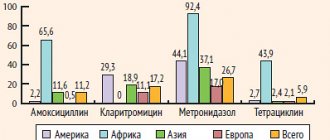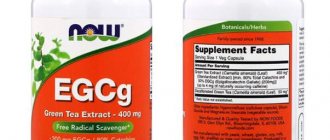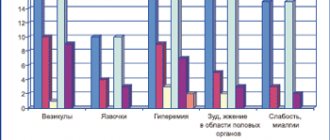Description
Capsule-shaped tablets of white or almost white color with a score.
Pharmacotherapeutic group:
antibiotic - semisynthetic penicillin
ATX code:
J01CA04
Pharmacological properties
Pharmacodynamics
Amoxicillin is an aminobenzyl penicillin, a semisynthetic broad-spectrum antibiotic that has a bactericidal effect due to inhibition of bacterial cell wall synthesis. Minimum inhibitory concentration (MIC) thresholds for different sensitive microorganisms vary. The prevalence of resistant strains varies geographically and over time, so it is advisable to rely on local resistance information, especially when treating severe infections.
Pharmacokinetics
Suction
Absorption is fast, high (93%), food intake does not affect absorption, and is not destroyed in the acidic environment of the stomach. When taken orally at a dose of 250 mg and 500 mg, the maximum concentration in blood plasma is 5 mcg/ml and 10 mcg/ml, respectively. The time to reach maximum concentration after oral administration is 1-2 hours.
Distribution
It has a large volume of distribution - high concentrations are found in blood plasma, bronchial secretions (in purulent bronchial secretions the distribution is weak), liver, lymph nodes, uterus, ovaries, paranasal sinuses, pleural and peritoneal fluid, saliva and tear fluid, urine, contents of skin blisters , lung tissue, intestinal mucosa, middle ear fluid and paranasal sinuses, bones, adipose tissue, gall bladder (the concentration in bile is 10 times higher than the concentration in blood plasma - with normal patency of the bile ducts), fetal tissues. When the dose is doubled, the concentration also doubles. In the amniotic fluid and umbilical cord vessels, the concentration of amoxicillin is about 50% of the concentration in the blood plasma of a pregnant woman. It penetrates poorly through the blood-brain barrier; with inflammation of the meninges (meningitis), the concentration in the cerebrospinal fluid increases to 20% of the concentration in the blood plasma. Bonding with blood plasma proteins is 15-25%.
Metabolism
Partially (10-20%) is metabolized to form inactive metabolites.
Removal
The half-life (T1/2) is 1-1.5 hours. It is excreted 50-70% unchanged by the kidneys through tubular excretion (80%) and glomerular filtration (20%), and 10-20% by the liver. A small amount is excreted in breast milk. If renal function is impaired (creatinine clearance [CC] ≤ 15 ml/min), T1/2 is extended to 8.5 hours.
Amoxicillin is removed by hemodialysis.
Special patient groups
Age
T1/2 of amoxicillin in children aged 3 months to 2 years is similar to T1/2 in older children and adults.
Since in elderly patients the likelihood of decreased renal function increases, dose selection is carried out with caution, and monitoring of renal function is also necessary.
Floor
When administered orally to healthy men and women, the gender of the patients does not have a significant effect on the pharmacokinetics of amoxicillin.
Kidney failure
The total serum clearance of amoxicillin increases in proportion to the decrease in renal function. If renal function is impaired (creatinine clearance < 15 ml/min), T1/2 lengthens and can reach 8.5 hours in anuria.
Liver failure
In patients with impaired liver function, dose selection should be carried out with caution, and regular monitoring of liver function is necessary.
Side effects of the drug Amoxil
When using Amoxil, the following are possible: allergic reactions: skin rash, itching, urticaria, hyperemia, fever, very rarely - erythema multiforme, Stevens-Johnson syndrome, toxic epidermal necrolysis, skin hyperkeratosis, bullous and exfoliative dermatitis, eczema, enanthema, anaphylactic shock and angioedema edema, serum sickness, vasculitis; from the gastrointestinal tract: nausea, vomiting, diarrhea, loss of appetite, dry mouth, taste disturbance, bloating, discomfort and pain in the abdomen, colitis (including pseudomembranous, hemorrhagic), change in tongue color (black “hairy” tongue ); from the urinary system : rarely - interstitial nephritis; from the hematopoietic organs : rarely - hemolytic anemia, reversible thrombocytopenia, eosinophilia, reversible leukopenia (including neutropenia, agranulocytosis), increased prothrombin time; from the liver and biliary system : moderate increase in the level of liver enzymes, very rarely - hepatitis, jaundice; from the central and peripheral nervous system : rarely - anxiety, restlessness, insomnia, loss of consciousness, behavioral disorders, hyperkinesia, dizziness, headache. In patients with impaired renal function, seizures are possible; Other : general weakness, development of superinfection, candidiasis of the mucous membranes, false positive results when determining the level of glucose in the urine using non-enzymatic methods and when conducting tests to determine urobilinogen.
Indications for use
Infectious and inflammatory diseases caused by microorganisms sensitive to the drug:
- upper respiratory tract infections (tonsillopharyngitis, sinusitis, acute otitis media);
- lower respiratory tract infections (acute bacterial bronchitis, exacerbation of chronic bronchitis, community-acquired pneumonia);
- infections of the genitourinary system (pyelonephritis, pyelitis, cystitis, urethritis, endometritis, cervicitis, gonorrhea);
- abdominal infections (cholangitis, cholecystitis);
- eradication of Helicobacter pylori
in patients with duodenal or gastric ulcers (always in combination with other drugs); - infections of the skin and soft tissues (erysipelas, impetigo, secondary infected dermatoses);
- leptospirosis, listeriosis;
- Lyme disease;
- infections of the gastrointestinal tract (enterocolitis, typhoid fever, dysentery, salmonellosis (caused by Salmonella typhi
, sensitive to ampicillin), salmonella carriage; - prevention of bacterial endocarditis during surgical procedures in the oral cavity and upper respiratory tract.
pharmachologic effect
Amoxicillin is an antibiotic that has a wide spectrum of effects. A group of antibiotics - semisynthetic penicillins . The abstract indicates that the drug is a 4-hydroxyl analogue of ampicillin . Provides a bactericidal effect. Demonstrates activity against aerobic gram-positive bacteria, namely Streptococcus spp., Staphylococcus spp. (except for those strains that produce penicillinase). Also active against aerobic gram-negative bacteria: Shigella spp., Neisseria gonorrhoeae, Escherichia coli, Neisseria meningitidis, Klebsiella spp., Salmonella spp.
Use during pregnancy and breastfeeding
Results from animal studies do not indicate direct or indirect effects on reproductive toxicity. Limited data on the use of amoxicillin during human pregnancy do not indicate an increased risk of congenital malformations. Amoxicillin can be used during pregnancy only in cases where the expected benefit to the mother outweighs the potential risk to the fetus.
Amoxicillin is excreted into breast milk in small quantities; if necessary, the drug can be used during breastfeeding. A breastfed baby may develop diarrhea, sensitization and fungal infection of the mucous membranes, so it may be necessary to stop breastfeeding. Amoxicillin should be used during breastfeeding only after the attending physician has assessed the benefit/risk ratio.
Drug interactions Amoxil
With the simultaneous use of amoxicillin and oral contraceptives, the effectiveness of the latter is reduced, and there is also a risk of bleeding. Increases the absorption of digoxin. Reduces clearance and increases toxicity of methotrexate. The excretion of amoxicillin from the body by the kidneys is reduced when used simultaneously with probenecid, oxyphenbutazone, phenylbutazone, acetylsalicylic acid, indomethacin, sulfinperazone. Drugs with a bacteriostatic effect (tetracyclines, macrolides, chloramphenicol) can neutralize the bactericidal effect of amoxicillin. Forced diuresis leads to a decrease in the concentration of amoxicillin in the blood serum due to increased elimination. When used simultaneously with allopurinol, an increase in the frequency of allergic reactions from the skin is possible. Concomitant use with antacids reduces the absorption of amoxicillin. When taken simultaneously with anticoagulants, monitoring of prothrombin time is necessary, as the likelihood of bleeding increases. The occurrence of diarrhea may reduce the absorption of other drugs and reduce the effectiveness of Amoxil. Amoxil may reduce the concentration of estradiol in the urine of pregnant women.
Directions for use and doses
Inside, before or after meals.
The dose of Amoxicillin depends on the sensitivity of the infectious agent, the severity of the disease and the localization of the infectious process.
Adults and children over 13 years of age and/or weighing more than 40 kg
Usually prescribed 250 mg - 500 mg 3 times a day or 500 mg - 1000 mg 2 times a day. For sinusitis, community-acquired pneumonia and other severe infections, it is recommended to prescribe 500 mg - 1000 mg 3 times a day. The maximum daily dose is 6 g.
Children from 3 to 5 years old and/or weighing from 15 kg to 19 kg
Usually prescribed 250 mg 2 times a day. In cases where there is a high likelihood of infection caused by resistant Streptococcus
pneumoniae
, higher doses of 500 mg 2-3 times daily are recommended.
Children from 5 to 13 years old and/or weighing from 19 kg to 40 kg
Usually recommended is 250 mg 3 times a day. In cases where there is a high likelihood of infection caused by resistant Streptococcus
pneumoniae
, higher doses are recommended - 500-1000 mg 3 times a day.
The maximum daily dose for children is 100 mg/kg/day.
Lyme disease (borreliosis)
—
early stage
Adults and children over 13 years of age and/or weighing more than 40 kg
500 mg - 1000 mg 3 times a day up to a maximum daily dose of 4 g, divided into several doses, for 14 days (10-21 days).
Children from 3 to 5 years old and/or weighing from 15 kg to 19 kg
250 mg 3 times a day.
Children from 5 to 13 years old and/or weighing from 19 kg to 40 kg
500 mg 2-3 times a day (at the rate of 50 mg/kg/day, divided into 3 doses).
Eradication of
Helicobacter pylori in patients with duodenal or gastric ulcers
(always in combination with other drugs)
Adults: 1000 mg twice daily in combination with a proton pump inhibitor (eg, omeprazole, lansoprazole) and another antibiotic (eg, clarithrominin, metronidazole) for 7 days.
Children over 13 years old and/or weighing more than 40 kg -
1000 mg 2 times as part of combination therapy.
Children from 3 to 5 years old and/or weighing from 15 kg to 19 kg
250-500 mg 2 times a day.
Children from 5 to 13 years old and/or weighing from 19 kg to 40 kg
500-1000 mg 2 times a day (at the rate of 50 mg/kg/day, divided into 2 doses).
Prevention of bacterial endocarditis
Adults and children over 13 years of age and/or weighing more than 40 kg
It is recommended 2 g (or at the rate of 50 mg/kg/day) 0.5-1 hour before surgery.
Children from 3 to 5 years old
u /or body weight from 15 kg to 19 kg
750-1000 mg (at the rate of 50 mg/kg/day) before the procedure.
Children from 5 to 13 years old and/or with a body weight of 19 kg and up to 40 kg
1000-2000 mg (at the rate of 50 mg/kg/day) before the procedure.
For renal failure
In patients with CC > 30 ml/min, there is no need for dose adjustment. When CC < 30 ml/min, it is recommended to increase the interval between doses or reduce subsequent doses.
Contraindications
Please note that the following contraindications to the use of this medicine are noted:
- severe infectious diseases of the gastrointestinal tract, in which the patient suffers from diarrhea , vomiting ;
- Infectious mononucleosis;
- lymphocytic leukemia;
- allergic diathesis;
- viral respiratory infections;
- hay fever;
- bronchial asthma;
- high sensitivity to cephalosporins , penicillins .
Medicines containing metronidazole should not be used in the following cases:
- for diseases of the nervous system;
- for hematopoietic disorders;
- for infectious mononucleosis and lymphocytic leukemia ;
- with severe sensitivity to nitroimidazole .
Medicines containing clavulanic acid should not be used if there is a history of jaundice or impaired liver function.
Reviews about Amoxicillin
Reviews about Amoxicillin on the Internet are mostly positive. They note that after the start of treatment the effect appears very quickly, the drug is convenient to use for both adults and children, for whom there is a special suspension for children. Also mentioned as a positive is that the medicine can be taken during pregnancy .
When discussing Amoxicillin, doctors' reviews are also positive. But experts always write that self-medication with the drug is unacceptable.
special instructions
Amoxicillin, as well as Amoxicillin Clavulanate and other types of the drug, should be taken with caution by people who are prone to allergic reactions.
liver disease , as well as those who are under 18 years of age, should not take the drug with metronidazole
Cross-allergy may occur in people who are hypersensitive to carbapenems and cephalosporins .
You should consider what Amoxicillin helps with. Thus, the drug is ineffective in the treatment of acute respiratory viral infections.
If the patient has severe gastrointestinal infections with symptoms of diarrhea and vomiting, then tablets should not be prescribed due to poor absorption.
The drug should be used with caution by people with bronchial asthma , allergic diathesis , and hay fever .
If the patient is forced to take the drug for a long time, he is additionally prescribed Levorin , Nystatin or other drugs with antifungal action.
It is important to monitor the condition of the kidneys, liver, as well as laboratory parameters of urine and blood in people who take large doses of the drug for a long time.
Patients who ask their doctor questions about whether Amoxicillin is an antibiotic or not should note that this drug is an antibiotic, so it is advisable to always consult a doctor before starting to take it. It is the doctor who determines how many days to take the medicine, as well as its dosage. You should not independently determine what Amoxicillin tablets help with and practice self-medication.
The drug for cats, dogs and other animals should be used only after a prescription by a veterinarian.
The combination of amoxicillin, omeprazole , clarithromycin is used to treat peptic ulcers.
Amoxicillin price, where to buy
The price of Amoxicillin in tablets of 500 mg is 30-35 rubles per pack of 10 pcs. The price of Amoxicillin 1000 mg depends on the manufacturer of the drug. The price of Amoxicillin suspension for children is on average 80-90 rubles per 100 ml bottle. You can buy the antibiotic Amoxicillin Clavulanate, which contains clavulanic acid , for a price starting from 250 rubles.
How much tablets cost in Ukraine (in Odessa, Kharkov and other cities) depends on their manufacturer. The cost of the drug is from 45 hryvnia for 10 tablets. Suspension for children can be bought for an average of 130 hryvnia. Amoxicillin ampoules can be purchased for 160 rubles.
- Online pharmacies in RussiaRussia
- Online pharmacies in UkraineUkraine
- Online pharmacies in KazakhstanKazakhstan
ZdravCity
- Amoxicillin tablets 500 mg 20 pcs. Biokhimik OJSC
77 rub. order - Amoxicillin capsules 500 mg 16 pcs. Hemofarm A.D. Vršac, Dubovac production site
105 rub. order
- Amoxicillin Sandoz tablets p.p.o. 1g 12 pcs Sandoz GmbH
RUB 159 order
- Amoxicillin Sandoz tablets p.p.o. 500 mg 12 pcs. Sandoz GmbH
127 RUR order
- Amoxicillin granules for prig suspension. for internal approx. 250mg/5ml 40gHemofarm A.D. Vršac, Dubovac production site
108 RUR order
Pharmacy Dialogue
- Amoxicillin capsules 500 mg No. 16Hemofarm
98 RUR order
- Amoxicillin Sandoz tablets 500 mg No. 12Sandoz
125 rub. order
- Amoxicillin tablets 500 mg No. 20Avva Rus
107 RUR order
- Amoxicillin granules for suspension 250mg/5ml 100mlHemofarm
91 rub. order
- Amoxicillin capsules 500 mg No. 16Barnaulsky ZMP
59 RUR order
show more
PaniPharmacy
- Amoxicillin 15% 100ml Ukraine, Olkar
252 UAH. order
show more
Amoxicillin analogues
Level 4 ATC code matches:
Hiconcil
Ampioks
Ampicillin Trihydrate
Ampicillin
Ospamox
Amoxicar
Penicillin
Flemoxin Solutab
Amosin
Amoxil
Ecoball
There are a number of analogues of this drug, which contain a similar active substance. The price of analogues depends on the manufacturer of the drug. Such medications are the following drugs: Amoxicillin trihydrate , Amoxicillin Sandoz , Flemoxin Solutab , Amoxicillin , Amosin , Amoxisar , Ecobol , etc.
Which is better: Amoxiclav or Amoxicillin?
Many patients believe that Amoxiclav and Amoxicillin are the same thing. But there is still a difference between these drugs. Amoxiclav contains clavulanic acid, so the drug has a wider spectrum of action. But this drug is more expensive.
Which is better: Flemoxin Solutab or Amoxicillin?
The drug Flemoxin contains a similar active substance. But Amoxicillin is more often used to treat adult patients. Flemoxin Solutab is absorbed faster from the gastrointestinal tract, it can be taken with meals, they have a pleasant taste. These tablets can be dissolved in water and prepared into a suspension or syrup. Flemoxin Solutab is a more expensive drug.
Overdose
As a rule, in case of overdose there is no pronounced toxic effect, even if a large dose of the drug was taken. If a large dose of Amoxicillin has been taken, the patient will experience symptoms of gastrointestinal upset and water-electrolyte imbalance. In people who suffer from renal failure, overdose may show signs of nephrotoxicity and crystalluria.
Symptomatic treatment is carried out, for which drugs prescribed by the doctor are used, and activated charcoal should also be taken. Hemodialysis may be used . There is no specific antidote.


